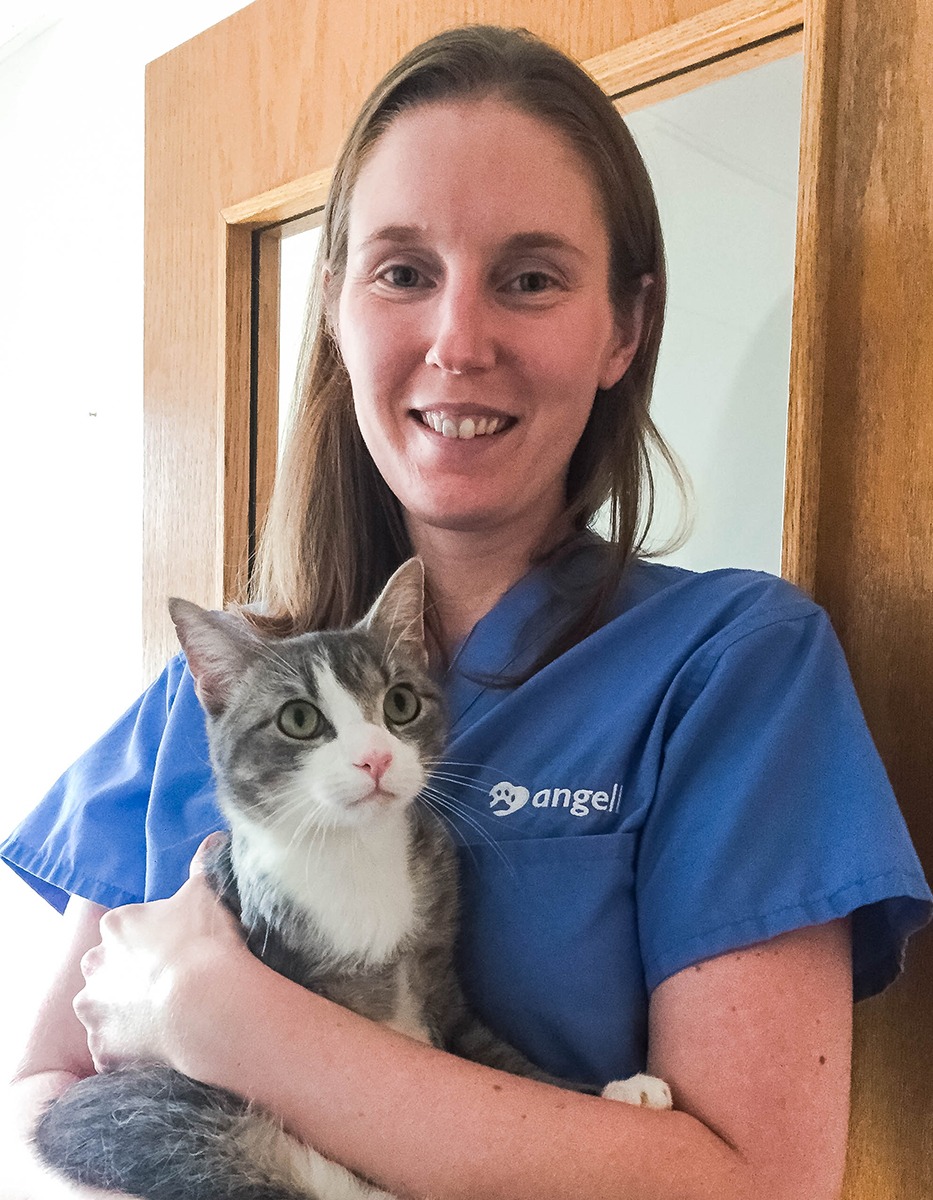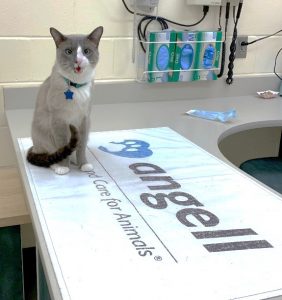-
Adopt
-
Veterinary Care
Services
Client Information
- What to Expect – Angell Boston
- Client Rights and Responsibilities
- Payments / Financial Assistance
- Pharmacy
- Client Policies
- Our Doctors
- Grief Support / Counseling
- Directions and Parking
- Helpful “How-to” Pet Care
Online Payments
Emergency: Boston
Emergency: Waltham
Poison Control Hotline
-
Programs & Resources
- Careers
-
Donate Now
 By Lisa Gorman, DVM, DACVIM
By Lisa Gorman, DVM, DACVIM![]()
angell.org/internalmedicine
MSPCA-Angell West
781-902-8400
Chronic kidney disease (CKD) is one of the most common diseases of older cats, affecting 15-30% of cats over 12 years of age.1 Kidney disease is also a major cause of mortality in cats, accounting for 13.6% of all deaths in cats 5 years or older in one study.2 Although many cats with chronic kidney disease can remain stable and minimally symptomatic for long periods of time, several variables have been found to be associated with faster progression of disease, including hyperphosphatemia, proteinuria, and anemia. In fact, for cats with stage 2 CKD, a 1% increase in packed cell volume (PCV) was found to correlate with a 10% reduction in the risk of disease progression.3 Anemia is also associated with shortened survival times in patients with CKD. While the overall survival from time of diagnosis for cats with CKD was just over 2 years in one study, cats with CKD that developed anemia were found to have a median survival time of just over 3 months from the onset of anemia.4 Since 30-65% of CKD cats will develop anemia at some point in the course of their disease,1 addressing anemia in these patients is an important consideration that can improve their length and quality of life.
There are a number of factors that may contribute to the development of anemia in CKD patients, including an inflammatory state resulting in iron sequestration, mucosal bleeding, decreased red blood cell survival due to uremia, medication effects, and poor nutritional status. However, the primary cause of anemia in CKD patients is loss of erythropoietin-producing cells in the kidney. Normally, specialized cells in the kidney produce erythropoietin (EPO) in response to renal hypoxia, which then serves as the main stimulus for new red blood cell production in the bone marrow. However, in CKD these cells die off, leading to reduced EPO production and in turn, reduced stimulation of erythropoiesis and subsequent non-regenerative anemia.1 Reduced EPO production has been confirmed in anemic CKD cats, with these cats having significantly lower EPO levels than non-anemic CKD cats.5
Synthetic forms of EPO have long been used in human patients to stimulate red blood cell production and combat anemia of CKD. Feline EPO shares approximately 83% homology with the human EPO molecule, which allows synthetic human EPO products to be used effectively in cats to stimulate red blood cell production.1 However, cats may produce antibodies against synthetic human EPO drugs which can then cross-react with their own native EPO. This may ultimately lead to pure red cell aplasia (PRCA), the most severe complication associated with use of synthetic forms of EPO. Although PRCA is rare in human patients receiving recombinant EPO products, it was reported in 25-30% of cats receiving epoetin, the earliest available form of recombinant human EPO.1 Because patients with PRCA are entirely transfusion dependent, often for months, many of these patients will ultimately die or be euthanized due to this complication. The higher likelihood of PRCA associated with epoetin in cats made its use limited to cats with severe anemia (hematocrit <20%), as in those cases the risk of PRCA would be worth the potential gain. Luckily, darbepoetin (Aranesp) has largely supplanted the use of epoetin due to its lower rate of developing PRCA (<10%) and its longer half-life allowing for once weekly dosing.1
One study evaluating the use of darbepoetin in anemic dogs and cats with CKD has been published to date. In dogs, use of darbepoetin in anemic CKD patients led to 85% of patients achieving a PCV of ≥30%, and 67% of patients experiencing a gain of PCV of ≥10%, with an average time to response of about 4 weeks. A higher starting dose of 0.8 µg/kg once weekly was associated with a better response than a dose of 0.5 µg/kg, which is closer to the starting dose typically used in people. Although increasing the dosing interval was attempted in most dogs, no dog was able to maintain their PCV at a dosing interval of 3 weeks or more, and many who went to an interval of 2 weeks required going back to a weekly interval to maintain PCV. Adverse events noted in dogs treated with darbepoetin included hypertension requiring medical treatment in 36% of patients, seizures in 15%, and possible PRCA in 6%.6
In a study of 25 anemic cats with CKD who were given darbepoetin and had at least 8 weeks of follow up, 56% had a durable response in which their PCV reached and stayed at ≥25%, with an average time to response of about 3 weeks. Ninety-three percent of responders were started at a dose of 1 µg/kg once weekly, indicating that this dose appears more effective in cats than the lower starting dose of 0.5 µg/kg once weekly used in some patients. Of the cats that did not respond, 64% had serious concurrent disease, and 45% initially responded but subsequently had their PCV drop below 25% despite continued darbepoetin therapy. This implies that as in human CKD patients, concurrent disease processes may drive anemia and contribute to a poor response to darbepoetin. Hypertension was noted at some point during treatment in 41% of patients, and acute neurologic signs or seizures were noted in 16%, most of which occurred in hypertensive cats. PRCA was considered as a differential for persistent anemia in 8% of cats, but was thought to be unlikely in both cases. Importantly, a significant survival advantage was noted in cats who responded to darbepoetin vs. non-responders, with median survival times of approximately 8 vs. 3 months, respectively.7 These results indicate that treatment with darbepoetin can correct anemia and prolong survival time in feline CKD patients.
Although the potential benefit of treatment with darbepoetin is clear, the best time to start treatment and what PCV to have as an end goal are not universally agreed upon. Traditionally, synthetic EPO has been recommended in veterinary patients when their PCV drops below 20%, or when they develop significant clinical signs of anemia. The target PCV to reach prior to reducing the darbepoetin dose is typically within the low end of the reference range. However, there is some evidence that even mild anemia predisposes patients to progressive disease. In one study, the median PCV of cats with progressive CKD was 33%, vs. 36% in cats with stable CKD,3 suggesting that even very mild degrees of anemia may have important consequences. This raises the question of if we should consider treating anemic CKD patients sooner and target a higher PCV than was traditionally recommended. Regardless, the most commonly recommended dosing protocol is 1 µg/kg darbepoetin SQ once weekly, along with 50 mg/cat (or 10-20 mg/kg for dogs) iron dextran IM every 1-2 months.8 Iron is recommended because iron deficiency is a known complication of darbepoetin therapy and one of the most common reasons for treatment failure in people.1 PCV and blood pressure should be rechecked weekly until the target PCV is reached. Once this has occurred, dosing can be reduced to every other week, and monitoring should continue to ensure an adequate response is sustained.8
Anemia is a common and potentially debilitating complication of CKD, leading to faster progression of disease and increased mortality. Treatment of anemia with darbepoetin is a viable option for these patients and can lead to improved survival and quality of life.
References
- Anemia of renal disease: what is it, what to do and what’s new. Chalhoub, S. et al. J Feline Med Surg (2011); 13: 629-640.
- Longevity and mortality of cats attending primary care veterinary practices in England. O’Neill, D. et al. J Feline Med Surg (2015); 17: 125-133.
- Clinicopathological variables predicting progression of azotemia in cats with chronic kidney disease. Chakrabarti, S. et al. J Vet Intern Med (2012); 26: 275-281.
- Survival in cats with naturally occurring chronic kidney disease (2000-2002). Boyd, L.M. et al. J Vet Intern Med (2008); 22: 1111-1117.
- Acute-phase proteins and iron status in cats with chronic kidney disease. Javard, R. et al. J Vet Intern Med (2017); 31: 457-464.
- The use of darbepoetin to stimulate erythropoiesis in the treatment of anemia of chronic kidney disease in dogs. Fiocchi, E.H. et al. J Vet Intern Med (2017); 31: 476-485.
- The use of darbepoetin to stimulate erythropoiesis in anemia of chronic kidney disease in cats: 25 cases. Chalhoub, S. et al. J Vet Intern Med (2012); 26: 363-369.
- Update on medical management of clinical manifestations of chronic kidney disease. Quimby, J.M. Vet Clin Sm Anim (2016); 46: 1163-1181.